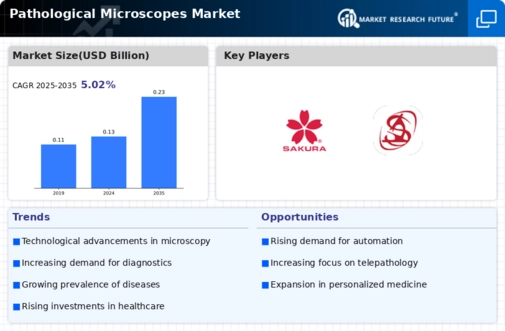Market Trends
Key Emerging Trends in the Pathological Microscopes Market
Pathological microscopes have become indispensable tools in the diagnostic landscape, particularly within diagnostic centers where their precision and capabilities are harnessed for the identification and analysis of chronic and infectious diseases. The surge in demand for diagnostic services, propelled by the escalating prevalence of chronic conditions such as cancer, diabetes, and tuberculosis, is reshaping the healthcare landscape. This surge not only underscores the pressing need for accurate and timely diagnoses but also fuels the expansion of diagnostic centers, thereby intensifying the demand for a range of medical instruments, including pathological microscopes. Chronic diseases, comprising a spectrum from cancer to diabetes, have witnessed a concerning rise globally. This upswing has created a parallel surge in the demand for diagnostic services that can effectively identify and monitor these conditions. The pivotal role of pathological microscopes in this context lies in their ability to provide detailed insights into cellular structures, aiding in the accurate diagnosis of chronic diseases. As diagnostic services become increasingly critical, the proliferation of diagnostic centers becomes evident, each equipped with the essential arsenal of medical instruments, including the highly sought-after pathological microscopes. The growth of diagnostic centers is not only a response to the rising prevalence of chronic diseases but also a proactive step to address the broader healthcare needs of populations. With an increasing emphasis on early detection and preventive healthcare, diagnostic centers play a pivotal role in delivering timely and accurate diagnoses, enabling medical professionals to initiate appropriate treatment plans promptly. This paradigm shift towards proactive healthcare is, in turn, driving the demand for advanced medical instruments that can enhance diagnostic accuracy, and pathological microscopes stand at the forefront of this technological evolution. The prevalence of infectious diseases further amplifies the demand for diagnostic services and, consequently, pathological microscopes. According to data from the Centers for Disease Control and Prevention (CDC), in 2016 alone, over 16.8 million individuals sought medical attention for infectious diseases. The ability of pathological microscopes to delve into the microscopic realm facilitates the identification and characterization of pathogens responsible for infectious diseases. In the context of infectious diseases, timely and accurate diagnoses are not only crucial for individual patient outcomes but also for public health surveillance and management. The market for pathological microscopes is intricately linked to the broader landscape of healthcare services. The rise in chronic and infectious diseases is steering the trajectory of this market, with manufacturers responding to the escalating demand by innovating and enhancing the capabilities of these critical instruments. The integration of advanced imaging technologies in pathological microscopes not only expedites the diagnostic process but also contributes to the overall efficiency of healthcare systems. Moreover, the increasing prevalence of chronic and infectious diseases underscores the need for a comprehensive and interconnected healthcare infrastructure. Pathological microscopes, as integral components of diagnostic services, contribute to the development of a robust healthcare ecosystem capable of addressing the evolving health challenges faced by populations. The surge in chronic and infectious diseases globally has become a catalyst for the growth of pathological microscopes in diagnostic centers. As the demand for diagnostic services continues to escalate, the number of diagnostic centers proliferates, amplifying the need for advanced medical instruments. Pathological microscopes, with their unparalleled capabilities in cellular analysis, stand as crucial contributors to accurate diagnoses, enabling healthcare providers to initiate timely interventions. The intersection of technological innovation and healthcare needs positions pathological microscopes at the forefront of the evolving diagnostic landscape.





Leave a Comment